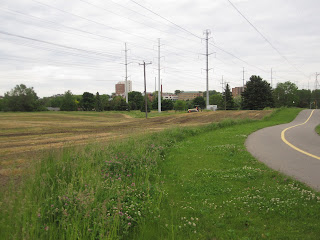In February, when I was deciding to move to a tower building, I had high hopes for the balcony garden I would create this year. Balcony repairs were necessary, however, and my outdoor space was closed until late June. Once my balcony opened up, I had quite a late start on my garden. I decided to take my own advice and start with a garden that was small and manageable. Over the past few months, I have gradually added more plants.
I've often had outdoor plants in containers. They work well in small spaces, concrete spaces, and temporary spaces. This is the first time that I've had all of my plants ten stories up on a south facing balcony. The wind and sun are a little more intense up here. With only a few pots, I've been able to keep up with watering and my herbs, native wildflowers, and grasses are flourishing in the full sun.
The large blue pot is full of a giant basil plant and it's three companions: sage, rosemary, and chives. The sage and rosemary have taken advantage of the slight shade provided by the basil bush. They also don't mind that the basil takes up all of the water. The small blue pot contains the little bluestem that I brought home on my bike from the Birds and the Bees picnic. It needs a some time to put down roots. The little white pot barely contains a wild strawberry. It's trying to reach out and has already put down roots beside the little blue.
On the other side, I have a lime tree, a blueberry bush, sweet basil, fennel, dill, pearly everlasting, butterfly milkweed, blue-eyed mountain grass, and an assortment of herbs.
And, I have this salad box hanging into my balcony. From top to bottom: radishes, spinach, and lettuce. They sprouted in one day and have taken off. This picture shows the plants at about ten days old.












